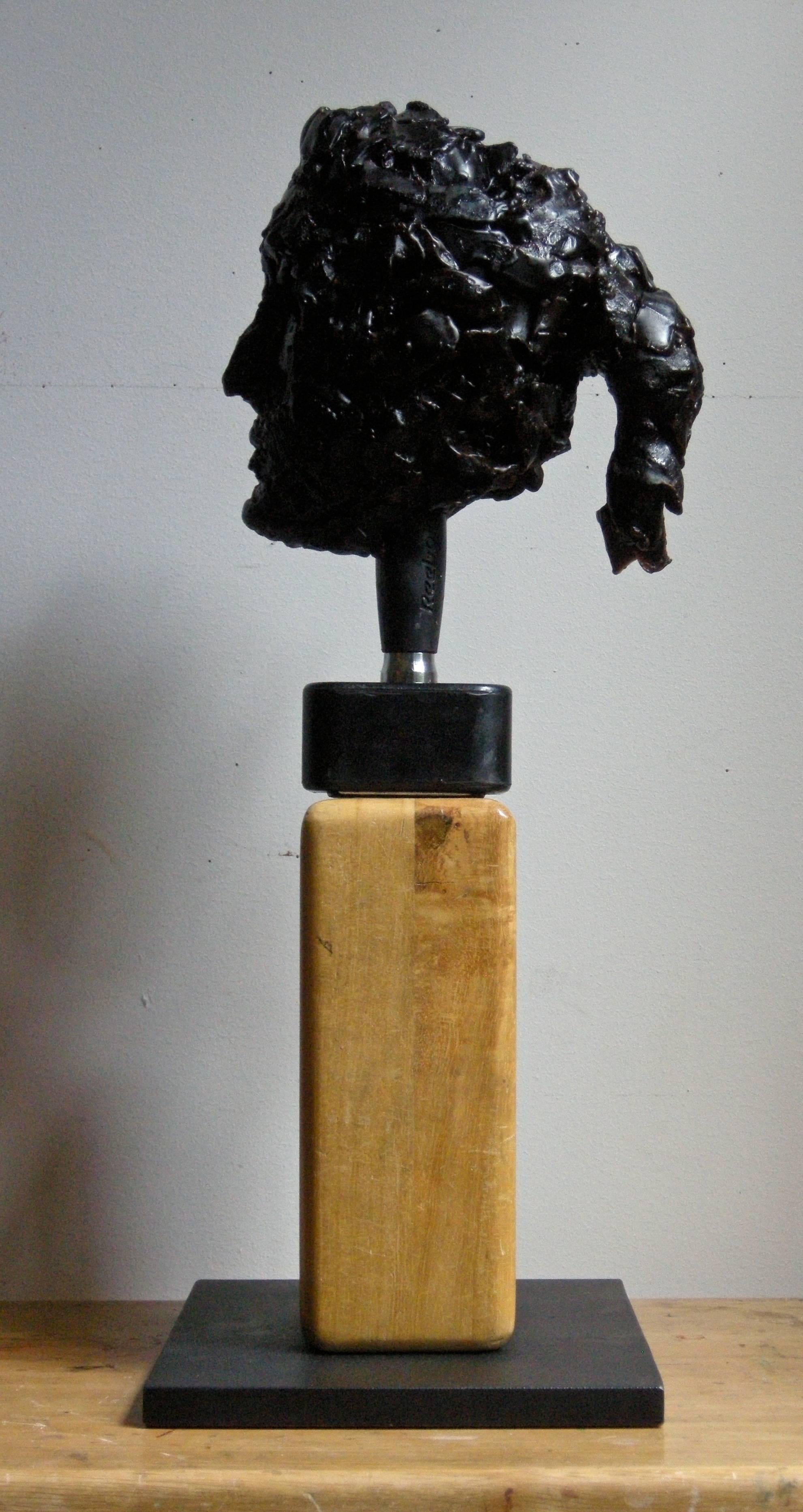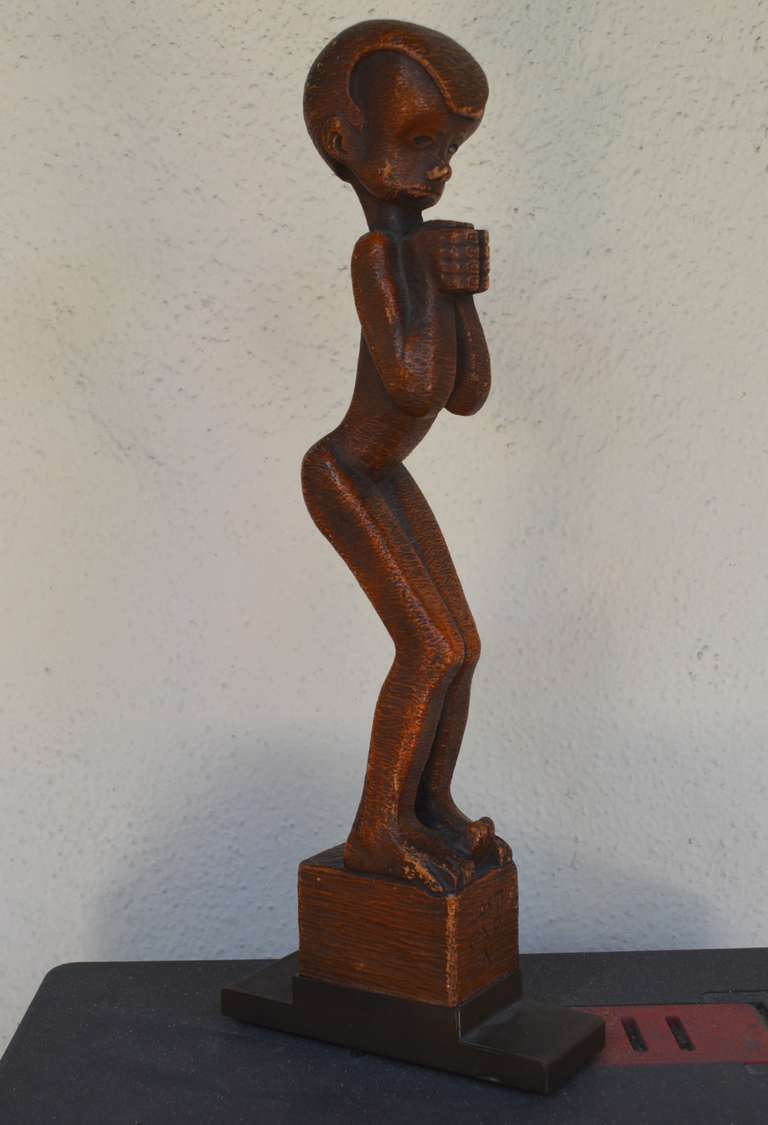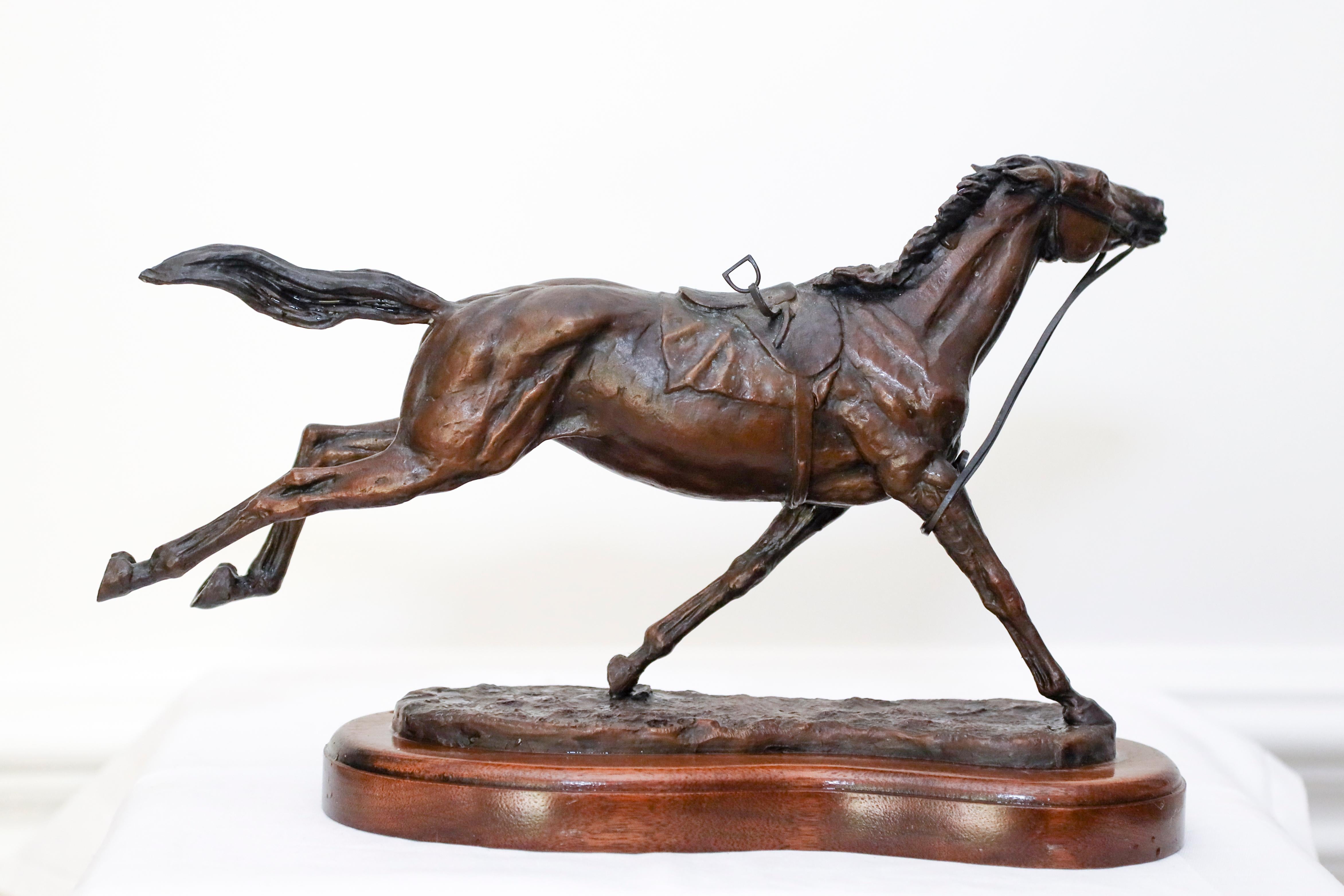Items Similar to An Early 20th Century Cigar Store Indian, Carved Wood With Polychrome Decoration
Video Loading
Want more images or videos?
Request additional images or videos from the seller
1 of 22
An Early 20th Century Cigar Store Indian, Carved Wood With Polychrome Decoration
About the Item
A 20th Century wood carved male figure, a 'Cigar Store Indian' with original polychrome decoration.
A now controversial subject, but none the less charming rendition, of a native North American man originally probably used as an advertising figure. Wonderful quality of carving capturing the stance of the man looking out to the distance, hair flowing to his back and plait to the side, all the details of his costume, his native dress and hairpipe breastplate (suggesting he is possibly a Comanche) and chest ornament, apron, trousers, mocassins, shield and arrows. The original Polychrome decoration has weathered beautifully as has the wood itself to present a sculpture that would adorn any collection or interior.
Because of the general illiteracy of the populace, early store owners used descriptive emblems or figures to advertise their shops' wares. American Indians and tobacco had always been associated because American Indians introduced tobacco to Europeans. As early as the 17th century, European tobacconists used figures of American Indians to advertise their shops.
Because European carvers had never seen a Native American, these early cigar-store "Indians" looked more like Africans with feathered headdresses and other fanciful, exotic features. These carvings were called "Black Boys" or "Virginians" in the trade. Eventually, the European cigar-store figure began to take on a more "authentic" yet highly stylized native visage, and by the time the smoke-shop figure arrived in the Americas in the late 18th century, it had become thoroughly "Indian."
According to an 1890 article in the New York Times:
It appears that the first man to introduce carved figures as tobacconists' signs was a certain Chichester. They were carved by one Tom Millard. This was about forty years ago. John Cromwell, Nick Collins, Thomas V. Brooks, and Thomas White are also prominent figures in the early history of the art.... Most of the men in the business originally carved figureheads for ships. But with the decay of American shipping they lost their occupation.... [S.A.] Robb himself brought a good artistic training to the workshop, for he studied at the Academy of Design for a number of years.
The Times article describes traditional fabrication techniques as follows. The wood was typically white pine, bought as logs at spar yards. The artist first blocked out a very rough outline by axe, guided by paper patterns. A hole was then bored into each end of the log, about 5 inches in depth, and a bolt placed into each. The log was then suspended from these bolts on supports so it could freely turn. The sculptor then used chisels, followed by finer carving tools, to create the finished figure. Arms and hands were created separately, then screwed into the body. The last steps were to paint it, and set it up upon a stand.
- Dimensions:Height: 37.01 in (94 cm)Width: 13.78 in (35 cm)Depth: 11.82 in (30 cm)
- Medium:
- Movement & Style:
- After:Samuel Robb (American)
- Period:
- Condition:Fair overall condition commensurate with age. The statue has been kept outside and this accounts for the weathering and extensive splitting (see photos), if kept in a more stable interior environment there should be no ongoing condition problems.
- Gallery Location:Cotignac, FR
- Reference Number:
About the Seller
5.0
Platinum Seller
These expertly vetted sellers are 1stDibs' most experienced sellers and are rated highest by our customers.
Established in 2000
1stDibs seller since 2020
157 sales on 1stDibs
Typical response time: 1 hour
- ShippingRetrieving quote...Ships From: Cotignac, France
- Return PolicyA return for this item may be initiated within 3 days of delivery.
More From This SellerView All
- 'Femme Assise'. Large Mixed-media Montage on Board.By Armand AvrilLocated in Cotignac, FRImposing and very large scale mixed media 'assemblage' by French artist Armand Avril. The work includes the French tricolour flag colours, his symbolic cat sculptures and a highly colourful geometric image of the artist's mother sitting in a chair. The work is signed and dated to the reverse and comes with a certificate of authenticity from the gallery. This montage fully demonstrates Avril's geometric period whilst also expressing the humour and joy that he puts into all his work. A very strong sculptural image and a feast for the eyes in searching for and recognising the everyday objects used in making this piece come alive. This montage is made from wood pieces, plywood, oil paint, acrylic, bottle top and nails . The more sculpted areas of the piece stand out up to 3cm from the frame. Armand Avril was born in 1926 in Lyon. His father, Marcel Avril was a painter and collector of African art. At 16 Armand became an apprentice shepherd in Provence. Avril could always be seen equipped with a sketchbook and a book on the history of art whilst tending his flock. It was not until the age of 30, in 1956, that Armand embarked on painting as an autodidact, influenced by Raoul Dufy, Pierre Bonnard, Henri Matisse and the Lyonnaise School of Painting. He exhibited for the first time in 1957. In 1960, he left for a one-year trip to Africa. There he met the painter Jean Arène who introduced him to the village of Cotignac in the Var and to Louis Pons...Category
Late 20th Century Abstract Expressionist Mixed Media
MaterialsWood, Plywood, Acrylic, Board
- Moi, Flags, Cats and Poppies, Very Large Scale Mixed Media 'Assemblage'By Armand AvrilLocated in Cotignac, FRImposing and very large scale mixed media 'assemblage' by French artist Armand Avril. The work includes the French tricolour flag, figures and heads in various poses, his symbolic cat sculptures and large stylised poppies. The work is not signed but comes with a certificate of authenticity from the artist. This montage fully demonstrates Avril's inspiration drawn from tribal art whilst also expressing the humour and joy that he puts into all his work. A very strong sculptural image and a feast for the eyes in searching for and recognising the everyday objects used in making this piece come alive. This montage is made from wood pieces, bottle tops, string, paint, cork, nails buttons, clothes pegs and netting. The more sculpted areas of the piece stand out up to 4cm from the frame. Armand Avril was born in 1926 in Lyon. His father, Marcel Avril was a painter and collector of African art. At 16 Armand became an apprentice shepherd in Provence. Avril could always be seen equipped with a sketchbook and a book on the history of art whilst tending his flock. It was not until the age of 30, in 1956, that Armand embarked on painting as an autodidact, influenced by Raoul Dufy, Pierre Bonnard, Henri Matisse and the Lyonnaise School of Painting. He exhibited for the first time in 1957. In 1960, he left for a one-year trip to Africa. There he met the painter Jean Arène who introduced him to the village of Cotignac in the Var and to Louis Pons...Category
Late 20th Century Tribal Mixed Media
MaterialsMetal
- Native North American Hopi Katsina (Kachina) Doll.Located in Cotignac, FRNative North American carved wood and painted effigy figure, Hopi Katsina or Kachina doll. This is one of a group of eight dolls all individually priced, or available as a set, and o...Category
Mid-20th Century American Impressionist Figurative Sculptures
MaterialsWood, Paint
- Native North American Hopi Katsina (Kachina) Doll.Located in Cotignac, FRNative North American carved wood and painted effigy figure, Hopi Katsina or Kachina doll. This is one of a group of eight dolls all individually priced, or available as a set, and ...Category
Mid-20th Century American Impressionist Figurative Sculptures
MaterialsWood, Paint
- Native North American Hopi Katsina (Kachina) Doll.Located in Cotignac, FRNative North American carved wood and painted effigy figure, Hopi Katsina or Kachina doll. This is one of a group of eight dolls all individually priced, or available as a set, and o...Category
Mid-20th Century American Impressionist Figurative Sculptures
MaterialsWood, Paint
- Native North American Hopi Katsina (Kachina) Doll.Located in Cotignac, FRNative North American carved wood and painted effigy figure, Hopi Katsina or Kachina doll. This is one of a group of eight dolls all individually priced, or available as a set, and ...Category
Mid-20th Century American Impressionist Figurative Sculptures
MaterialsWood, Paint
You May Also Like
- StingareeBy David EverettLocated in Dallas, TX"Stingaree" by artist David Everett is polychromed mahogany, and measures 43 3/8 x 40 1/4 x 21 1/2 inches. It is signed "© D EVERETT 2017". It depicts a mother and child, pelican and...Category
2010s American Realist Figurative Sculptures
MaterialsPaint, Mahogany
- Bust / Head No. 2 2014 (with Yoga Block and Dumbell)By John GoodmanLocated in Burlingame, CAContemporary bust / sculpture: created from wax, wire mesh, dumbell and yoga block, by American artist John Goodman, whose work has been deeply inf...Category
21st Century and Contemporary American Realist Figurative Sculptures
MaterialsSteel, Wire
- Farmer Han and the Farmer's WifeBy Dee ClementsLocated in Loveland, COFarmer Han and the Farmer's Wife by Dee Clements Figurative Bronze Pair. Excellent condition. Has been reviewed by the artist. Farmer Han, measures 33x11x14", limited edition of 21,...Category
1980s American Realist Figurative Sculptures
MaterialsGranite, Bronze
- Last One In!By Burton FreundLocated in West Hollywood, CAAn original WPA wood sculpture by Chicago artist Burton Freund. Freund worked for the FAP(Federal Arts Project) in Chicago in the 1930's as well as an accomplished illustrator for so...Category
1930s American Realist Figurative Sculptures
MaterialsWood
- Dog Scratching Bronze of a Dog ScratchingBy Charles RumseyLocated in Brookville, NYCharles Cary Rumsey attended Harvard University, studied art in Paris at the Academie Julian and at Boston School of Fine Art under Bela Pratt. His public works are found worldwide, such as the frieze at the Manhattan Bridge, Zion Park...Category
1910s American Realist Figurative Sculptures
MaterialsBronze
- Bronze Bust of a Gentleman by Nison TregorLocated in Brookville, NYNison Tregor Born in Lithuania of Polish parents, Nison Tregor studied sculpture at the Warsaw Academy of Fine Arts. After immigrating to the United State...Category
1940s American Realist Figurative Sculptures
MaterialsBronze





